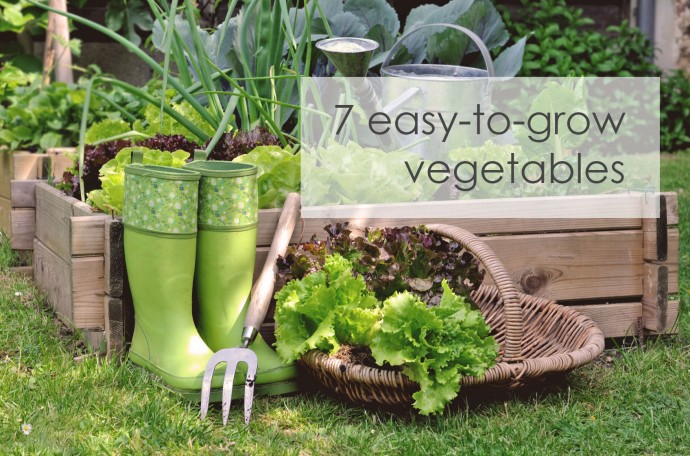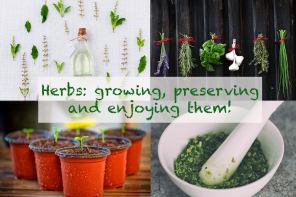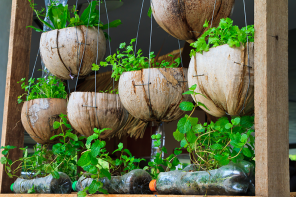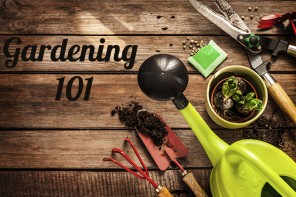For the last few years, gardening has gained popularity. We harvest healthy, fresh vegetables, but we’re also proud of growing our own food.
Gardening is a fascinating hobby that anyone can do, even beginners. Growing veggies doesn’t require any particular skill, just time, care and a little passion! Just starting your first garden? Here are 7 veggies that are easy to grow which makes them perfect for beginner gardeners.
The ABC’s of growing vegetables
Before throwing yourself completely into your garden, you have to plan. Here is some advice to start your garden on the right foot!
Find the right spot
Optimize your garden’s yields by choosing the perfect spot to put it. Three criteria needed for choosing the right spot for your garden are: it must be sunny, accessible and drain well.
First, a garden needs 6 to 8 hours of sunlight per day, so choose a spot in your yard that’s exposed to the sun.
Then, make sure that your garden isn’t close to any trees because their roots can take over and kill your veggies!
Finally, the soil in your garden must be able to drain well. Dig deep enough to put a lot of earth or opt for an elevated garden framed with boards like this one:

Prepare the soil properly for better sowing
Your veggies will need a lot of nutrients. That’s why you have to prepare the earth properly to give your plants all the sustenance they’ll need. Cover the soil with 4 to 5 cm of compost and use a spade to turn it and integrate it well. Also, mix with slow-release organic fertilizer and follow the recommended use.
Weed the soil carefully before planting to ensure that there are no undesirables, then smooth out with a rake. Voilà! Now you’re ready to sow your garden.
Tips and advice for good seeding
For the best results, you have to seed at the right time and adapt to the type of vegetable, as well as air and soil temperature.
Most leafy vegetables (like lettuce, spinach, cabbage) and root vegetables (like radish, beets, potatoes) like the coolness and will grow better if you seed early once the soil has defrosted and drained well, but before the last frost.
On the other hand, fruit vegetables like tomatoes, cucumber and zucchini don’t like the chill. Not only should you wait until after the last frost to seed or transplant, but also that the soil and air are warm enough. A lot of gardeners check the weather and plant vegetables when nighttime temperatures are above 10 ˚C.
How to sow a vegetable, step by step
Most seeds will start sprouting 5 to 14 days after sowing.
*For the recommended depth and spacing, consult the vegetable guide for beginner gardeners below.
How to transplant a tomato, step by step
Transplanting a tomato consists of taking the seedling and replanting in a larger pot or in the earth. Here’s how:
7 vegetables for beginner gardeners
Lettuce
Leafy lettuce (frisée lettuce) is the most popular and the easiest to grow.
Sow it in the open ground around the beginning of May. Since it ripens quickly, sow more every 2 weeks until the beginning of September to ensure a continuous harvest.
Sow the seeds .6 to 1.5 cm deep and 4 cm apart. When the leaves start to touch, clear them out to leave 15 to 20 cm between the plants. You can eat the baby lettuce that was removed. They’ll be your first harvest!
Lettuce is sensitive to drought, so it’s better to keep the soil a little damp at all times by watering regularly.
Depending on the variety, harvest lettuce leaves at 40 to 60 days by cutting the plant at the base.
Good companions: carrots, cabbage, cucumbers, onions, tomatoes
Bad companions: celery, parsley
Tomatoes
To grow a tomato well, it’s important to know if it’s determinate or indeterminate. Determinate tomatoes grow to a compact height and don’t necessarily need a stake. Their fruit ripen more quickly and all at the same time. Indeterminate tomatoes ripen more slowly, but over a longer period giving you a lot more fruit. Most importantly, they need a solid support like a stake or tomato cage as the plants grow all summer.
This vegetable ripens too slowly for direct seeding in the garden. Instead, you should transplant the seedling plant indoors. If it’s your first time, it’s easier to buy seedling plants that have already been started instead of growing them yourself.
Make sure that the soil is hot to the touch and that nighttime temperatures stay generally above 10 ˚C. Transplant seedling plants 50 cm apart.
Water well throughout the summer. If you grow seedling plants on a stake, you have to tie them with string. If you grow it on only one stake, trim the secondary branches, otherwise the stake won’t be able to support their weight. If you plant it in a tomato cage, trimming won’t be necessary.
For a better taste, harvest fruit when they’re a nice, vibrant colour.
Good companions: carrots, asparagus, basil, onion
Bad companions: potatoes, cabbage
Zucchini
Zucchini is a summer squash that grows quickly and abundantly. You can grow from purchased seedling plants or those sown indoors, but also by seeding directly in the earth.
When soil and air are warm enough, sow 3 seeds 2.5 cm deep and 70 cm apart (we always sow a few more, just in case). Water well.
When the seedlings start sprouting, remove the surplus so there is only one seedling per spot to avoid overpopulation. Harvest zucchini when they’re still young and tender, 15 to 20 cm in length. The more you harvest, the more the plant will produce!
Good companions: basil, corn
Bad companions: cucumber
Cucumber
Cucumbers are a close relative to the zucchini and share several traits. As for zucchini, you can buy seedlings or sow them indoors 3 weeks before the last frost, but also outdoors.
Wait until the air and soil are warm enough before sowing this veggie because it doesn’t like the cold. Sow three seeds per hole, 1.5 cm deep and 45 cm apart, then water well. If all the seedlings sprout, remove all but one.
Cucumbers produce the nicest fruit when they climb, so attach a garden net onto stakes along the rows. The seedlings will climb because of their tendrils.
To get nice cucumbers, soil moisture must remain relatively constant. Water the soil when it starts to dry out.
Harvest cucumbers when they’re about 15 cm in diameter. The more often you harvest, the more they’ll bear fruit.
Good companions: beans, peas, celery, lettuce
Bad companions: zucchini, potatoes
Radishes
Radishes are super-fast veggies often ready to eat in only 25 to 35 days. They prefer fresh soil, so start seeding very early, about 3 to 4 weeks before the last frost.
Sow them 1.5 cm deep and 2.5 cm apart, then sow more every two weeks in mid-June to stretch the harvest because it generally gets hot after that. Start sowing every two weeks again at the end of August and into September for a fall harvest.
Root vegetables are harvested when they’re 2 to 3 cm in diameter. Don’t leave them in the soil too long. They’ll get woody and bitter.
Good companions: cucumber, zucchini, peas, lettuce
Bad companions: vines
Beans
There are two types of beans: dwarf beans and pole beans. Dwarf beans ripen more quickly, but the pods grow at the same time. Pole beans grow more slowly, but continue to bear fruit for the rest of the summer. It might be interesting to plant both to extend the harvest season.
Wait until there is no risk of frost or until the soil is nice and warm before sowing.
Sow them 2 cm deep and 8 cm apart, then water well.
Install a support for pole beans, maybe a trellis or net stretched across two 1.5 m stakes. The plants will climb without help because of their expansive stems.
Beans have to be harvested when the pods are still thin. If they start to look bumpy, they’ll taste pasty. The more you harvest, the more they’ll produce.
Good companions: beets, cabbage, carrots, tomatoes
Bad companions: garlic, leek
Beets
Beets do very well in fresh soil. They’re normally sown 3 to 4 weeks before the last frost.
Sow the seeds 1.25 cm deep and 30 cm apart. Each “seed” is in fact a glomerulus of 2 to 4 seeds, so several will sprout at each spot. Make sure to clear them out so only one seedling plant grows. As the leaves are edible, the little seedling plants that you cleared can be put directly onto your plate!
The roots grow fairly quickly and you can try a harvest of baby roots after approximately 50 days. They will continue to get bigger all summer long for a last harvest at the end of August.
Good companions: cabbage, onions, radishes
Bad companions: pole beans, spinach
Anyone can grow veggies, even beginners. Start with vegetables that are easy to grow like the ones in this article. You’re guaranteed to get great results!
Nothing’s impossible when it comes to growing veggies. You can grow veggies in the city or in the country. And a gardening mistake can always be fixed. Want to learn more about growing vegetables? Read our article on Gardening 101!








